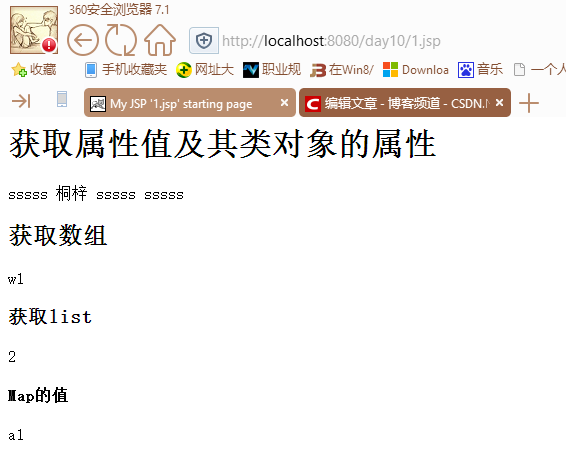问题?EL表达式是什么?作用是做什么
定义:EL(Expression)表达式
它只是JSP中的表达式,不是一种开发语言。基本语法:${EL表达式}
*****EL表达式只能获取四大域中的数据。
EL表达式获取的对象如果是null,页面不会显示数据。因此,EL表达式中永远不会出现空指针异常
p.name:调用域中名称为p对象的getName方法,点运算符是用于获取属性的取值的。
.运算符:
[]运算符:.运算符能做的,[]也能做。[]能做的,.不一定能做。
比如${p.name}===${p['name']}==${p["name"]}
优秀在可以取不符合Java命名规范的东东。
2.数学逻辑运算:
empty运算符:如果判断的对象是null或者空字符串,都返回true。对于集合,即使集合对象本身不是null,没有任何元素,也返回true。
三元表达式的使用(在开发中经常用,特别是session用户登陆)
<body>
<jsp:useBean id="p" class="com.dp.javaweb.domain.bean"></jsp:useBean>
<h1>empty判断是否存在域对象</h1>
${empty p }<br/><!-- 判断对象是否为空对象,无对象返回true -->
${empty "" }<br/>
<%
List list=new ArrayList();
list.add("343");//如果没有加东西,则可以判断是空对象
pageContext.setAttribute("list", list);
%>
${empty list }
<hr/>
<h1>三元表达式的使用</h1>
<%
session.setAttribute("user", "Mr_li13");
%>
${empty user?"请登录":"欢迎您:" }${user}<br/>
<%pageContext.setAttribute("s","1") ;%>
${s=="0"?"女":"男" }
</body>EL表达式不支持字符串连接操作。
例子:
Bean类
package com.dp.javaweb.domain;
import java.io.Serializable;
import java.util.Date;
public class bean implements Serializable{
//80%的类都实现这个接口,虽然并不是都用,但是养成良好的习惯是好的
private String username="sssss";
private String password;
private boolean marry;
private Date birthday;
private Adress adress=new Adress();
public Adress getAdress() {
return adress;
}
public void setAdress(Adress adress) {
this.adress = adress;
}
public Date getBirthday() {
return birthday;
}
public void setBirthday(Date birthday) {
this.birthday = birthday;
}
public bean() {
// TODO Auto-generated constructor stub
}
public bean(String username, String password, boolean marry, Date birthday,
Adress adress) {
super();
this.username = username;
this.password = password;
this.marry = marry;
this.birthday = birthday;
this.adress = adress;
}
public String getUsername() {
return username;
}
public void setUsername(String username) {
this.username = username;
}
public String getPassword() {
return password;
}
public void setPassword(String password) {
this.password = password;
}
public boolean isMarry() {//is和get是一样的
return marry;
}
public void setMarry(boolean marry) {
this.marry = marry;
}
}
adress类
package com.dp.javaweb.domain;
public class Adress {
private String city="桐梓";
public String getCity() {
return city;
}
public void setCity(String city) {
this.city = city;
}
}
jsp
<%@page import="com.dp.javaweb.domain.bean"%>
<%@ page language="java" import="java.util.*" pageEncoding="UTF-8"%>
<%
String path = request.getContextPath();
String basePath = request.getScheme()+"://"+request.getServerName()+":"+request.getServerPort()+path+"/";
%>
<!DOCTYPE HTML PUBLIC "-//W3C//DTD HTML 4.01 Transitional//EN">
<html>
<head>
<base href="<%=basePath%>">
<title>My JSP '1.jsp' starting page</title>
<meta http-equiv="pragma" content="no-cache">
<meta http-equiv="cache-control" content="no-cache">
<meta http-equiv="expires" content="0">
<meta http-equiv="keywords" content="keyword1,keyword2,keyword3">
<meta http-equiv="description" content="This is my page">
<!--
<link rel="stylesheet" type="text/css" href="styles.css">
-->
</head>
<body>
<jsp:useBean id="p" class="com.dp.javaweb.domain.bean"></jsp:useBean>
<h1>获取属性值及其类对象的属性</h1>
<%=p.getUsername() %>
${p.adress.city }<!-- 取bean类中的属性类的对象的属性值时注意是否实例化 -->
${p.username }
${p['username'] }<!-- 另一种方式 -->
<h2>获取数组</h2>
<%
String a[]={"w","w1"};
pageContext.setAttribute("a",a);//将对象设置到page域中
%>
${a[1] }
<h3>获取list</h3>
<%
List list=new ArrayList();
list.add("1");
list.add("2");
list.add("3");
pageContext.setAttribute("list", list);
%>
${list[1]}
<h4>Map的值</h4>
<%
Map map=new LinkedHashMap();
map.put("a", "a1");
map.put("b", "b1");
map.put("c", "c1");
pageContext.setAttribute("map",map);
%>
${map.a }
</body>
</html>





























 1190
1190

 被折叠的 条评论
为什么被折叠?
被折叠的 条评论
为什么被折叠?








